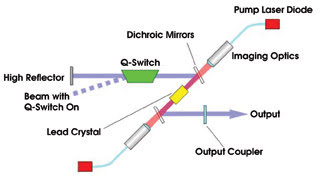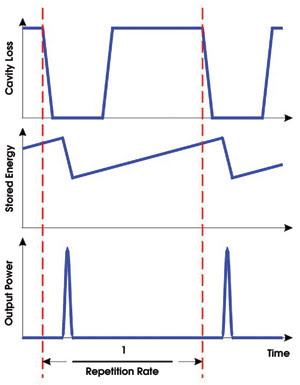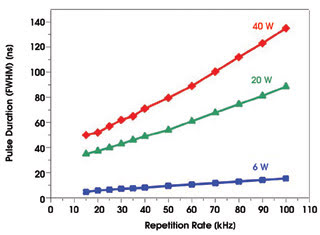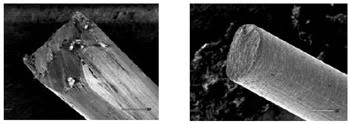The trend toward shorter pulses, higher repetition rates and higher output powers will certainly continue as these lasers tackle more types of materials-processing applications.
Dr. Norman Hodgson and Mark Keirstead
Since their introduction a decade ago, there have been nearly continuous
improvements in the performance and reliability of diode-pumped, single-transverse-mode,
solid-state lasers with Q-switched operation. Current systems can deliver low noise
output at 1064, 532, 355 and 266 nm at 10 times the power levels of those first
lasers, with maintenance intervals reaching 10,000 hours or more. As a result of
these advances, applications now range from stereolithography and hard disk texturing
to resistor trimming, memory repair, via hole drilling, structuring of printed circuit
boards, wafer scribing and marking.
For market expansion to continue, though, lasers
must compete against and displace alternative technologies, such as traditional
machine tools, even more than they already have. This will require further improvements
in processing speed and process quality through advances in areas such as laser
materials, optomechanical design and control electronics.

Figure 1. A convenient pump
and resonator geometry for Q-switched lasers results from the use of dichroic mirrors
to pass the pump light and reflect the laser emission. External frequency-multiplication
optics allow output at harmonics of the fundamental wavelength.
Q-switch basics
In a typical end-pumped, Q-switched laser, light
transfers from the pump laser diodes via fiber bundles into the laser head, where
imaging optics direct it into the laser crystal. To maximize efficiency, system
designers closely match the pump light illumination distribution with the TEM00
mode volume of the crystal. A convenient pump and resonator geometry results from
the use of dichroic mirrors, which pass the pump light (typically at 808 nm) and
reflect the laser emission (usually at 1064 nm). The laser resonator itself consists
of a rear high reflector, the Q-switching element, the laser crystal and an output
coupler (Figure 1). Output at harmonics of the fundamental wavelength is possible
with the use of external frequency multiplication optics.
The Q-switching element acts as a shutter.
Open, it allows feedback within the laser cavity. Closed, it creates high loss or
frustrates the feedback process. The Q-switching process is thus relatively straightforward.

Figure 2. During Q-switching, a laser emits
one pulse per cycle. Shown are typical variations in Q-switch state (cavity loss),
energy storage and output power as a function of time.
Initially, one sets the element to
create high loss and prevent lasing. During this time, the pump energy, which the
laser system continuously supplies, accumulates in the laser crystal. With the Q-switch
off, the cavity loss decreases to zero. After energy builds up, the system emits
a short pulse that uses all the stored gain and drops the output back to essentially
nothing (Figure 2). Typical buildup time is 100 ns to 1 μs, with output pulse
duration reaching 5 to 100 ns. The system then turns the Q-switch back on, and the
process repeats (Figure 3).
Almost all current industrial lasers
use an acousto-optic deflector as the Q-switching element. When powered, the deflector
diffracts the beam at a small angle. This induced misalignment creates the necessary
cavity loss. The fast switching time of acousto-optic technology also enables repetition
rates of up to 500 kHz.

Figure 3. Both pulse duration and output power increase
with repetition rate for a Q-switched laser. As a result, laser
designers tend to optimize one parameter at the expense
of the other.
Shorter pulses
While the marketplace continues to demand higher
power output from Q-switched lasers, a variety of applications also can benefit
from shorter pulse durations, which often lead to smaller heat-affected zones. To
understand how these are achieved, it is necessary to examine in more detail how
the various Q-switching parameters interact (see table).
 First, it is important to note that
pulse duration increases almost linearly with repetition rate. To minimize pulse
duration, even at high repetition rates, it is necessary to use a laser crystal
with a large emission cross section, which is why most high-power Q-switch systems
use Nd:YVO4. For a given resonator and pumping configuration, the high emission
cross section of Nd:YVO4 creates pulses half as long as those obtained using Nd:YAG.
First, it is important to note that
pulse duration increases almost linearly with repetition rate. To minimize pulse
duration, even at high repetition rates, it is necessary to use a laser crystal
with a large emission cross section, which is why most high-power Q-switch systems
use Nd:YVO4. For a given resonator and pumping configuration, the high emission
cross section of Nd:YVO4 creates pulses half as long as those obtained using Nd:YAG.
System designers could decrease pulse
length by reducing resonator length, but this would also reduce output power. Although
increasing the intensity of the supplied pump light could mitigate this effect somewhat,
there are limitations. The diameter of the TEM00 mode scales with resonator length,
so a shorter resonator produces higher pump intensity for the same supplied pump
power. (The system must focus the same amount of pump light into a smaller spot.)
The problem is that there is an upper limit on pump intensity beyond which thermal
effects will degrade the output power and beam quality. For Nd:YVO4, this occurs
at a pump-light intensity of about 10 kW/cm2.
As a result, development strategies
for Q-switched diode-pumped solid-state lasers have split into two distinct directions.
The first achieves higher output power by increasing resonator length and thus generating
longer pulses. An example is a periodic resonator design in which the cavity consists
of two (or more) laser rods in series, with each pumped from both ends. By increasing
the number of pump beams, system designers can deliver more pump power before the
laser reaches its intensity limits. Spectra-Physics’ Inazuma series Nd:YVO4
lasers, for example, offer 35 W at 1064 nm, with an M2 of less than 1.3. The pulse
repetition rate is adjustable between 15 and 100 kHz, with maximum output power
occurring at 30 kHz.
The second approach uses shorter resonators
to reduce pulse duration, but at some sacrifice in total power. The best performance
available from this technique comes from systems that employ a special pump configuration
to limit the thermal impact of the high pump intensity on the laser crystal. The
output characteristic of one such laser is 17 W at 1064 nm (at 40 kHz), with an
M2 of less than 1.2. The pulse length at 1064 nm is just 15 ns.
Whatever the approach, laser reliability,
efficiency and maintenance characteristics are just as important as performance
to the industrial market. In fact, these practical considerations are often the
factors that determine laser acceptance in new application areas. Such needs are
what fueled the development of the sealed laser head. This involves removing the
only consumable (the pump diode array) from the laser head, assembling long-lived
optical components in a monolithic structure with permanent mounting, designing
this structure to be thermally stable, and building the laser in a cleanroom atmosphere
and then factory-sealing it.
The sealed laser head eliminates the
possibility of optics contamination and precludes the need for periodic cleaning.
Avoiding laser damage from contamination is critical to reliably achieving the high
peak powers that the Q-switching technique provides.
An important factor in the sealed design
is the use of a monolithic resonator structure to deliver cavity stability and to
permanently eliminate the need for optics adjustment. By mounting all cavity optics
on a single aluminum I-beam base, system designers can ensure that a configuration
delivers excellent torsional stability and produces highly stable output power and
mode quality.
Application notes
The Q-switched laser’s unique combination
of output characteristics makes it useful in many applications. One example is the
micromachining of silicon substrates during the solar cell manufacturing process.
Fagor Sistemas, S.Coop., of Mondragón,
Spain, supplies manufacturing automation and control systems, primarily to the automotive
and microelectronics industries. In its solar cell production system, a robot arm
loads individual silicon substrates onto a movable X-Y table. A 10-W Q-switched
laser, operating at 1064 nm and a 100-kHz repetition rate, then ablates a complex
pattern in the material. This pattern consists of hundreds of lines from 10 to 20
μm wide. The system must be able to process about 500 cells per hour, 24 hours
a day, seven days a week.
“Fast processing speed was an
essential requirement for this application,” said Jose Otxoa of Fagor Sistemas.
“For this reason, we could not use a chemical etching process, and traditional
machine tools would damage the relatively delicate material. Only the Q-switched
laser met all our conditions. It possesses the TEM00 mode quality that enables us
to focus down and produce fine features, the high peak power necessary to rapidly
ablate the material and a high repetition rate so that the cuts appear continuous,
even when the X-Y table is moved at high speed.”
This inherent flexibility of Q-switched
lasers provides another advantage, especially for job shops such as Mound Laser
and Photonics Center of Miamisburg, Ohio. The center applies and develops laser
materials-processing technology for several industries, including medical, microelectronics,
consumer products and defense (Figure 4).

Figure 4. Flexible processing parameters can give Q-switched lasers an economic edge over other machine tools in micromachining applications such as the processing of iridium wire: the electronic sensor component cut with a traditional tool (left), and cut with a 4-W
Q-switched laser operating at 355 nm and 5 kHz (right). Courtesy of Mound Laser
and Photonics Center.
“We work with a wide variety
of materials, including metals, polymers and ceramics. The jobs we get are diverse,
ranging from high-precision work to applications where speed and throughput are
the most important criteria,” said president and CEO Larry Dosser. “For
example, if the situation calls for high-throughput metal micromachining, then the
high pulse energy and average power available at 1064 nm is advantageous. But 1064-nm
processing tends to be more thermal and less ablative, resulting in more recast
material (melted material that is ejected and redeposited during processing) and
a larger [heat-affected zone].
“This is acceptable for some
applications, but if it isn’t, a shorter wavelength, such as 355 nm, is preferred.
The bottom line is a trade-off between speed and quality that is important to understand
and critical to the economics of laser micromachining. The large choice of output
options and wavelengths from Q-switched lasers enables us to place ourselves anywhere
along that continuum for a given task.”
The ability to precisely control the
output of a Q-switched laser is fundamental to the success of the hard disk texturing
process used by manufacturers such as Seagate Technology LLC of Fremont, Calif.
This application involves roughening part of the normally very flat surface of a
computer hard disk to create a “landing zone.” The flat read/write head
can then safely touch down on this area without sticking. The Seagate process uses
a 1064-nm laser to create 30,000 to 600,000 bumps about 5 nm high and 5 μm
in diameter on the surface of a disk in just a few seconds.
“It’s essential to avoid
producing a regular, periodic pattern, because this can generate resonance and instability
in the head,” said engineering director Jack Xuan. “To obtain the randomization
in bump size and spacing we need, we continually vary the repetition rate by up
to 25 percent from the nominal and also change pulse contour. This unique capability
of the Q-switched laser, together with its overall reliability and speed, has enabled
our process from both a technical and cost standpoint.”
As diode-pumped solid-state Q-switched
lasers continue their inroads into these and other materials-processing applications,
the trend toward shorter pulses, higher repetition rates and higher output powers
is certain to continue. Laser manufacturers will achieve these through improvements
to design forms as well as novel approaches such as oscillator/amplifier configurations.
About the authors
Norman Hodgson is director of engineering and
Mark Keirstead is marketing manager for the OEM business unit of Spectra-Physics
in Mountain View, Calif.